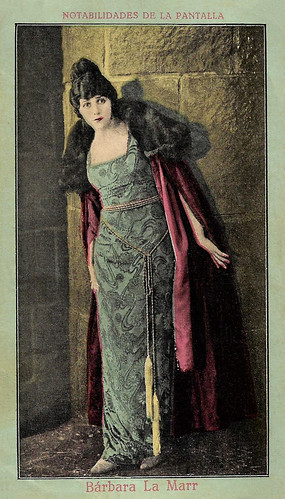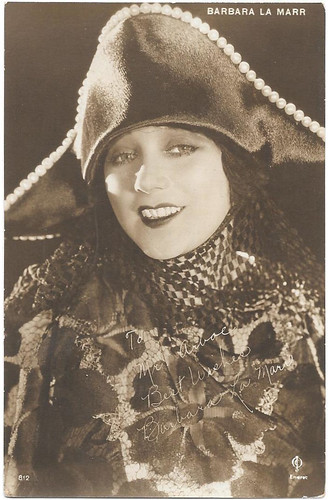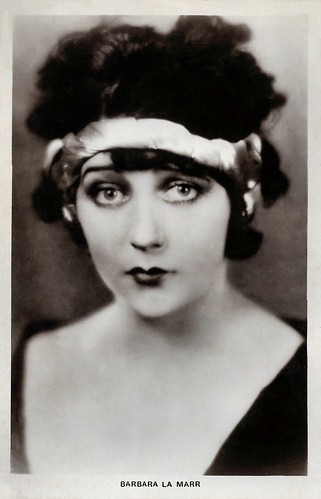
German postcard by Ross Verlag, Berlin, no. 793/1, 1925-1926. Photo: Transocean-Film-Co., Berlin.

French postcard by Editions Cinémagazine, no. 159. Photo: Hoover.
Femme fatale
Barbara La Marr was born Reatha Dale Watson in Yakima, Washington, in 1896. Her parents were William and Rosa/Rose Watson. Her father was an editor for a newspaper and her mother, a native of Corvallis, Oregon, already had one son, Henry, and a daughter, Violet, from a previous marriage.
She spent her early life in the Pacific Northwest. She made her acting debut in Tacoma in 1905 and appeared in child roles for a few years. In 1909, she relocated with her family to California.
After performing as a ballroom dancer and in Vaudeville under her new name of Barbara La Marr, she moved to Los Angeles with her then-husband, Vaudevillian Ben Deely. She became a screenwriter for Fox Film Corporation and wrote six films for the company. She was credited as writer Barbara La Marr Deely on the films The Mother of His Children, The Rose of Nome, Flame of Youth, The Little Grey Mouse, and The Land of Jazz (all released in 1920).
She made her film debut in Harriet and the Piper (Bertram Bracken, 1920), starring Anita Stewart. Though a supporting part, the film garnered her attention from audiences.
La Marr made the successful transition from writer to actress with her supporting role in The Nut (Theodore Reed, 1921), in which she played a femme fatale opposite Douglas Fairbanks. Later the same year, she was hired by Fairbanks to play the substantial part of Milady de Winter in The Three Musketeers (Fred Niblo, 1921), starring Douglas Fairbanks as d'Artagnan.

Spanish collectors card by Chocolates selectos Evaristo Juncosa Pañella, Barcelona, in the Notabilitades de la pantalla. Series B, no. 8. (A series of 15 pictures). Barbara La Marr as Antoinette de Mauban in The Prisoner of Zenda (Rex Ingram, 1922).
Too beautiful and young to be on her own in the big city
In the following years, Barbara La Marr acted frequently in films. She became known to the public as "The Girl Who Is Too Beautiful", after Adela Rogers St. Johns, a Hearst newspaper feature writer, recalled in an article she wrote in 1922 for Photoplay that, in 1914, Barbara has been sent back to her parent's by the Los Angeles Juvenile Bureau because she was "too beautiful and young to be on her own in the big city." This kind of publicity did much to promote her career.
She also made two further career-boosting films with director Rex Ingram, The Prisoner of Zenda (1922), and Trifling Women (1922), both with Ramon Novarro.
Then, La Marr signed with Arthur H. Sawyer to make several films for various studios, including The Hero (Louis J. Gasnier, 1923), Souls for Sale (Rupert Hughes, 1923) with Eleanor Boardman, and The Shooting of Dan McGrew (Clarence G. Badger, 1924), the first and last of which she co-wrote.
During her career, she became known as the pre-eminent vamp of the 1920s. She partied and drank heavily, once remarking to the press that she only slept two hours a night.
In 1924, during the filming of Thy Name Is Woman (Fred Niblo, 1924), production supervisor Irving Thalberg made regular visits to the set to ensure that La Marr's alcoholism was not interfering with the shoot. The same year, La Marr's first starring, above-the-title role came in the drama Sandra (Arthur H. Sawyer, 1924). La Marr had served as a co-writer on the film, which focused on a woman suffering from a split-personality disorder. Upon release, the film received dismally negative reviews.

German postcard by Ross Verlag, no. 697/5, 1919-1924. Photo: BAFAG (British-American-Films A.G.). Ramon Novarro and Barbara la Marr in The Prisoner of Zenda (Rex Ingram, 1922).

Danish postcard by J. Chr. Olsons Kunstforlag, Eneret, no. 812. Collection: Didier Hanson.
A series of crash diets for comeback roles
Barbara La Marr's health began to falter after a series of crash diets for comeback roles further affected her lifestyle. It led to her death from pulmonary tuberculosis and nephritis. While shooting The Girl from Montmartre (Alfred E. Green, 1925) in early October 1925, La Marr collapsed on set. The studio wrapped production without her with the use of a double in long shots. She was only 29 when she passed away on 30 January 1926.
The Girl from Montmartre was a critical and commercial success. Barbara La Marr was posthumously honoured on the Hollywood Walk of Fame for her contributions to the film industry. La Marr officially was married four times.
La Marr's first marriage in 1914, was to Max Lawrence, who later turned out to be a former soldier of fortune named Lawrence Converse. He already was married with children when he married La Marr under a false name and was arrested for bigamy the following day. Converse died following a brain operation on the 27 June 1914.
In 1916, La Marr married Philip Ainsworth, a noted dancer. Although the son of well-off parents, Ainsworth eventually was incarcerated at San Quentin State Prison for passing bad checks, and the couple divorced in 1917. She married for a third time to Ben Deely in 1918. He was over twice her age, an alcoholic and a gambling addict. The couple separated in 1921. Before the divorce from Deely was finalised, La Marr married actor Jack Daugherty in 1923. Despite separating a year later, they remained legally married until her death.
Some years after La Marr's death, it was revealed that Marvin Carville La Marr, the son she had claimed to have adopted in 1923, was her natural child, born in 1922. The name of the boy's father has never been released. During her final illness, La Marr entrusted the care of her son to her close friend, actress ZaSu Pitts, and Pitts' husband, film executive Tom Gallery. After La Marr's death, the child was legally adopted by Pitts and Gallery and was renamed Donald Gallery. He died in 2014.

British postcard in the Picturegoer Series, London. Photo: Metro.

British postcard in the Picturegoer Series, London, no. 185.
Sources: Wikipedia and IMDb. With special thanks to Marlene Pilaete for additional information!
This post was last updated on 25 January 2025.
No comments:
Post a Comment